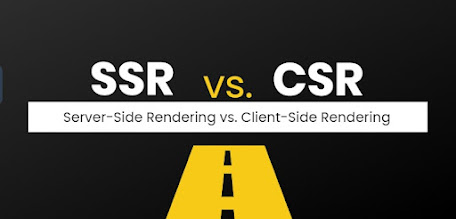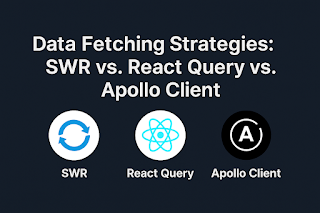Server-Side Rendering (SSR) vs. Client-Side Rendering (CSR)
In the evolving world of frontend development, how your app
renders content can significantly impact performance, SEO, and user
experience. Two popular rendering techniques are Server-Side Rendering
(SSR) and Client-Side Rendering (CSR). Let’s break down the
differences, pros, and cons of each—and help you decide which approach suits
your needs.
What is Server-Side
Rendering (SSR)?
With SSR, the server renders the full HTML of a page
and sends it to the client. The browser receives a fully formed HTML document,
which gets displayed quickly.
// SSR with Next.js
export async function getServerSideProps() {
const data = await fetchData();
return { props: { data } };
}
Advantages:
- Faster
initial page load
- Great
for SEO
- Content
is available before JavaScript loads
Disadvantages:
- Slower
subsequent page navigation
- More
server load
- Complex
to cache dynamically generated pages
What is Client-Side
Rendering (CSR)?
In CSR, the server sends a minimal HTML shell and the
browser uses JavaScript to render the content dynamically. Frameworks like
React (CRA), Angular, and Vue often default to this method.
Example:
useEffect(() => {
fetch('/api/data')
.then(res => res.json())
.then(setData);
}, []);
Advantages:
- Faster
navigation between pages after initial load
- Better
interactivity and dynamic UI updates
- Reduces
load on server after the first request
Disadvantages:
- Slower
first paint
- SEO
challenges (content isn’t visible to crawlers unless pre-rendered)
- Heavier
initial JavaScript load
SSR vs CSR: Quick Comparison
|
Feature |
SSR |
CSR |
|
Initial Load Speed |
Faster |
Slower |
|
SEO Support |
Excellent |
Needs extra setup |
|
Server Load |
Higher |
Lower |
|
Interactivity |
Requires hydration |
Immediate |
|
Best Use Case |
Blogs, e-commerce, news |
Dashboards, SPAs, admin UIs |
Which Should You
Choose?
- Use
SSR when:
- SEO
is crucial (e.g. blogs, marketing sites)
- Content
needs to appear instantly
- Use
CSR when:
- You’re
building a highly interactive app
- SEO
isn’t a top priority (e.g. dashboards)
Or go hybrid with frameworks
like Next.js that support both SSR and CSR, so you can tailor
rendering strategies per page.
Summary
Choosing between SSR and CSR depends on your project’s
goals. While SSR offers better SEO and faster first loads, CSR provides
dynamic, app-like experiences. Understanding both helps you build performant,
scalable web apps.
Which rendering method have you used in your latest project—and why?
#WebDevelopment #SSR #CSR #Frontend #ReactJS #NextJS #JavaScript #WebPerformance #SEO #RenderingStrategy #SolutionArchitecture
.jpg)



Comments
Post a Comment